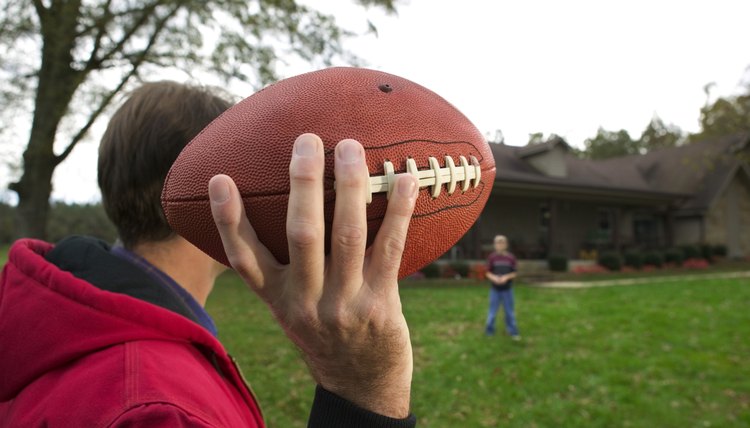Which Muscles Are Used When Throwing a Football?

When a quarterback drops back to throw, commentators and fans often analyze the pass and the quarterback's arm strength. Not many people talk about which muscles are used and influence the throwing motion in football. Understanding which muscles do the work can help you set up your training regimen to throw the football harder and farther.
Shoulder Muscles
The shoulder muscles are heavily involved in the throwing motion in football, first to support the arm and then during the motion and follow-through. According to an "American Journal of Sports Medicine" study led by B.T. Kelly, the anterior deltoid, middle deltoid, supraspinatus and infraspinatus all are active throughout the throwing motion. These muscles are all around the shoulder joint, with the deltoids being two of the larger shoulder muscles and the supraspinatus and infraspinatus being part of the rotator cuff muscles that help you rotate your arm to finish the throw.
Arm Muscles
The large arm muscles of the triceps, biceps and forearm are involved in the throwing motion, especially once you begin the throw. During the setup or cock phase, only the bicep and forearm muscles are at work, but as you begin to drive and throw the ball, the triceps help to push your arm through while the biceps and forearm help finish the follow-through.
Other Upper-Body Muscles
According to Kelly, the pectoralis major, lats or latisimus dorsi and the subscapularis are most responsible for velocity during the throw. The pectoralis major, or pec, is the large muscle in the chest, while the lats are the large muscles on each side of your back, directly under your armpits. The subscapularis is another rotator cuff muscle in the shoulder. All of these muscles, combined with the arm muscles, are extremely active during the throw as you prepare to release the ball.
Lower Body and Core Muscles
The lower body and the core muscles are often forgotten in the football throw. However, some of the first coaching points a young quarterback receives is to stay balanced, drive with the back foot, step into the throw and follow through. The core muscles of the abdominals and obliques are involved in the balance and weight transfer of the throwing motion. The large muscles of the legs and lower body, such as the calves, quadriceps, hamstrings and glutes, all help to drive and provide power as you step into the throw.
References
Writer Bio
Based in Harker Heights, Texas, Timothy Onkst has been writing about sports, fitness and health since 2003. His articles have appeared in a variety of publications including "Texas Roundball" magazine, Yahoo Sports, Fox Sports and other websites.
